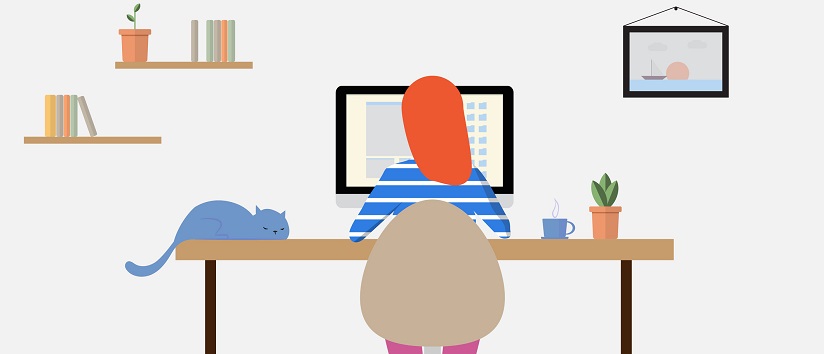What are the important lessons to learn from the pandemic for work and wellbeing?
26 May 2021
The working landscape has shifted so much in the last 15 months, particularly for those who work in offices. With all office workers thrown into working from home since the advent of the first national lockdown in March 2020, many adjustments have had to be made and many questions around what normal is going to look like post-pandemic have been raised. But what are the main lessons to be learnt from this transformative year when discussing work and mental health?
Open dialogue and nurturing a respectful environment
The World Health Organization (WHO) note that mental health is not a black and white matter of those diagnosed with a mental disorder and those who aren’t are healthy, instead they see it as “mental health is a state of well-being in which an individual realizes his or her own abilities, can cope with the normal stresses of life, can work productively, and is able to make a contribution to his or her community.”
The pandemic has inarguably had one of the broadest and most consistent impacts on mental health that anyone alive today has ever seen. The Office of National Statistics (ONS) reported earlier this month that we are seeing an increase of more than double the number of adults experiencing depression than before the pandemic, from 10% to 21%.
All these stats, and headlines that read “tidal wave of mental illness” and “unavoidable mental health crisis” could be enough to completely resign ourselves to the inevitability of the negatives that might come as a result of the pandemic. However, where attitudes towards mental health in the workplace are concerned there is an opportunity to use these extenuating circumstances to enact sustainable and impactful change.
One thing that many of us have likely noticed during the pandemic has been frank and honest discussions around the reality of mental health. Whether this be simply acknowledging that you are struggling, or opening up about a diagnosis, or that you’re going to therapy. There have been many instances over the past year of honesty around mental health, from celebrities to your average citizen, that has not been seen on this scale ever before.
- See also: 'Could green social prescribing provide the link between mental and physical health?'
- See also: 'How the unreal world of the pandemic has impacted dissociative symptoms'
- See also: 'Quantity or quality? Mind’s report on remote therapy asks questions about standards of care'
Only this week, Labour MP Nadia Whittome spoke about her experience with post-traumatic stress disorder (PTSD) and that she has made the decision to take time off work after talking to her GP.
So what does this say about our possible changing attitudes towards mental health in the workplace? As a culture we are slowly moving towards normalizing conversations on mental health and nowhere is this more important than in the workplace.
Davida Ginter, author of ‘Burning Out Won’t Get You There’ addresses in a piece for Forbes, the fact that although progress has been made, particularly in the workplace there is still stigma. To combat this stigma, she suggests actively incorporating the honest discussions around mental health we’ve been seeing this past year into “designated spaces”, where regular check ins can facilitate employees to discuss their struggles.
Ginter also emphasises the fact that it is important that this does not become performative, but that management and leadership should ask questions to really draw out honest answers such as “How are you – really?” and even more importantly to follow this up with “How can I support you? What do you need?” and have pathways of support that they can offer up if an employee does need it.
An open dialogue of respect and honesty such as that which Ginter suggests, allows employees to simultaneously look after their own mental health whilst allowing management and leadership to put their productivity or progression into the context of mental health; giving them the opportunity to adjust or tailor an employees role for optimum fulfilment.
Hybrid working: making the best of both worlds
Vitality, a health and life insurance provider has partnered up with the RSA to conduct a report on UK workers’ perspective on working from home and in-office working. The report has found that only 16% of workers would want to be in a physical location full time as we move out of lockdown and 48% saying a ‘hybrid’ or flexible working pattern where they split time between home and the office is most desirable.
Gemma Dale, a senior HR professional and author of ‘Flexible Working’ spoke to Stylist on home-working, “One of the main benefits for employees working from home is a reduction in commuting, and the associated times and costs. This time can be used for activities that support wellbeing such as exercise, time with friends and family or hobbies.”
This suggests one of the main benefits of home-working is the ability for people to have more autonomy when it comes to their work/life balance. Instead of having strict times of the day or week in which activities or practices that boost wellbeing can occur, workers have more time and more flexibility to fit work around activities and vice versa, in reference to this Dale said, “autonomy in this way can support overall wellbeing.”
However, Dale reiterates that this is only truly effective when clear boundaries are set for at home work in regards to work/life balance to ensure people aren’t finding it hard to ‘switch off’ after a day of work, that people aren’t tempted to work overtime etc.
To avoid the possible negative impacts of either full-time in-office working or homeworking, the hybrid, flexible work model is gaining a lot of attention and being seen as a valid alternative by employees and management alike.
In the UK you can request a flexible working arrangement after 26 weeks of continuous service. If you believe this is something that would work best for you (part-time at-home and part-time in-office) it is important to consider how this arrangement will best support your mental health and wellbeing.
Think about times during the week where you might benefit most from being in the office, say for meetings and collaborative work, and then other times where you might benefit on a productivity level and wellbeing level from home; an example of this might be that if you are in therapy and experience anxiety the day of therapy at work or the day after, you can work your hybrid model around that and ensure you are looking after your mental health whilst still being able to work from home.
Gemma Dale notes that “Getting good working habits and routines is key to making the most of hybrid working.” This conversation around new ways of discussing mental health in the workplace, as well as accommodating it through different kinds of working is at its heart, all about ensuring we all get the most out of being in a place of work that values and respects our mental health.


Comments
Write a Comment
Comment Submitted